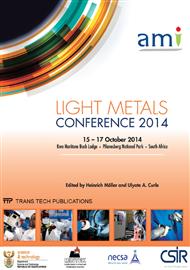p.177
p.187
p.195
p.204
p.210
p.218
p.225
p.231
p.241
Thermo-Gravimetric Analysis and Debinding Study of Powder Injection Moulded Titanium Alloy
Abstract:
An investigation into the solvent and thermal debinding behaviour of a typical paraffin wax-polymer binder system for titanium alloy Ti-6Al-4V powder injection moulding (PIM) feedstock was conducted. Details of the mixing parameters, powder loading, temperature and mixing speed were evaluated for optimal compounding of the feedstock. The feedstock was injection moulded into 22 mm diameter by 3 mm thick disks. Debinding is conducted in two stages, an initial solvent debinding step to remove the waxes, followed by a thermal debinding step to remove the polymers. Solvent debinding was conducted by immersing the injection moulded specimens in n-heptane heated to 50 °C for a period of 5 hours. The mass loss rate was logged during solvent debinding in order to determine the efficiency of the solvent debinding step. From these measurements, it was determined that 94 wt% of the wax (paraffin wax and stearic acid) components of the binder were removed during solvent debinding. A thermo-gravimetric analysis (TGA) was conducted in air on the Ti-6Al-4V powder, as well as the green and solvent debound feedstock. These results show the effect of debinding the feedstock in air and were used to design a thermal debinding cycle for the system.
Info:
Periodical:
Pages:
210-217
Citation:
Online since:
October 2014
Authors:
Price:
Сopyright:
© 2014 Trans Tech Publications Ltd. All Rights Reserved
Share:
Citation:


